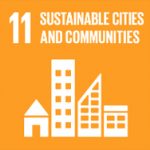The global campaign for sustainability will be won, or lost, in cities.
Between 70% and 80% of all people are expected to live in urban areas by 2050. Consequently, smart city planning and urban development strategies are instrumental to making sure there is enough biological regeneration to avoid excessive human demand that would erode it. See the Power of Possibility for how many days city interventions can #MoveTheDate of Earth Overshoot Day. Examples include energy-efficient buildings, integrated zoning, compact cities, and effective options for people-powered and public transportation. They’re creative, economically viable, and ready to deploy at scale. With them, we can make ourselves more resilient. If we move the date 6 days each year, humanity can be out of overshoot before 2050.
 UN Sustainable Development Goal 11 Sustainable Cities and Communities features several 2030 targets, including:
UN Sustainable Development Goal 11 Sustainable Cities and Communities features several 2030 targets, including:
- reduce the adverse per capita environmental impact of cities.
- provide access to safe, affordable, accessible and sustainable transport systems for all, notably by expanding public transport.
- enhance inclusive and sustainable urbanization and capacity for participatory, integrated and sustainable human settlement planning and management in all countries.
To be sustainable, development ultimately must also fit within our planet’s resource budget.
Transportation
In particular, city planning can play a major role in shaping our need for cars. It matters because personal mobility makes up 17% of humanity’s carbon Footprint.
Strategies for One-Planet Prosperity
How to build lasting success on our finite planet
Strategies for One-Planet Prosperity
How to build lasting success on our finite planet






